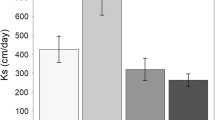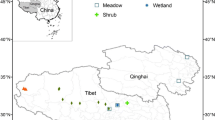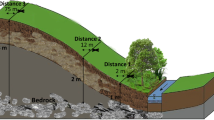Abstract
Soil organic matter (SOM) is the largest terrestrial C pool, and retention and release of dissolved organic matter (DOM) cause formation and loss of SOM. However, we lack information on how different sources of DOM affect its chemical composition, and how DOM chemical composition affects retention. We studied seasonal controls on DOM production and chemical controls on retention in soils of a temperate coniferous forest. The O horizon was not usually the dominant source for dissolved organic C (DOC) or N (DON) as has been reported for other sites. Rather, net production of both DOC and DON was often greater in the shallow mineral soil (0–10 cm) than in the O horizon. DOM production in the shallow mineral soil may be from root exudation as well as turnover of fine roots and microflora in the rhizosphere. In the field, the two acid fractions (hydrophobic and hydrophilic acids) dominated the soil solution at all depths. A major portion of net production and removal of total DOC within the soil column was explained by increases and decreases in these fractions, although a shift in chemical composition of DOM between the O and mineral soil horizons suggested different origins of DOM in these layers. A larger loss of the free amino fraction to deep soil water at this study site than at other sites suggested lower retention of labile DON. Field DOM removal measurements suggest that field-measured parameters may provide a good estimate for total DOM retained in mineral soil.
Similar content being viewed by others
References
Antweiler RC & Drever JI (1983) The weathering of a late Tertiary volcanic ash: importance of organic solutes. Geochim. Cosmochim. Acta 47: 623–629
Cabrera ML & Beare MH (1993) Alkaline persulfate oxidation for determining total nitrogen in microbial biomass extracts. Soil Sci. Soc. Am. J. 57: 1007–1012
Christ MJ & David MB (1996) Dynamics of extractable organic carbon in Spodosol forest floors. Soil Biol. Biochem. 28: 1171–1179
Currie WS, Aber JD, McDowell WH, Boone RD & Magill AH (1996) Vertical transport of dissolved organic C and N under long-term N amendments in pine and hardwood. Biogeochemistry 35: 471–505
Dai KH, David MB & Vance GF (1996) Characterization of soil and dissolved carbon in a spruce-fir Spodosol. Biogeochemistry 35: 339–365
Dalva M & Moore TR (1991) Sources and sinks of dissolved organic carbon in a forested swamp catchment. Biogeochemistry 15: 1–19
David MB & Vance GF (1995) Carbon controls on Spodosol nitrogen, sulfur, and phosphorus cycling. In: Carbon Forms and Functions in Forest Soils (pp. 329-354). 8th North American Forest Soils Conference, Gainesville, Florida, 1993. Soil Sci. Soc. Am. J. Madison, WI
Grayston SJ, Vaughan D & Jones D (1996) Rhizosphere carbon flow in trees, in comparison with annual plants: the importance of root exudation and its impact on microbial activity and nutrient availability. Appl. Soil Ecol. 5: 29–56
Greenland DJ (1971) Interactions between humic and fulvic acids and clays. Soil Sci. 111: 34–41
Grier CC & Logan RS (1977) Old-growth Pseudotsuga menziesii communities of a western Oregon watershed: biomass distribution and production budgets. Ecol. Monogr. 47: 373–400
Guggenberger G, Zech W & Schulten H (1994) Formation and mobilization pathways of dissolved organic matter: evidence from chemical structural studies of organic matter fractions in acid forest floor solutions. Organic Geochem. 21: 51–66
Harmon ME (1992) Long-term experiments on log decomposition at the H.J. Andrews Experimental Forest. USDA Forest Service Pacific Northwest Research Station. General Technical Report PNW-GTR-280. January.
Herbert BE & Bertsch PM (1995) Characterization of dissolved and colloidal organic matter in soil solution: a review (pp. 63-88). 8th North American Forest Soils Conference, Gainesville, Florida. 1993. Soil Sci. Soc. Am. J. Madison, WI
Jandl R & Sollins P (1997) Water-extractable soil carbon in relation to the belowground carbon cycle. Biol. Fertility Soils 25: 196–201
Jardine PM, Weber NL & McCarthy JF (1989) Mechanisms of dissolved organic carbon adsorption on soil. Soil Sci. Soc. Am. J. 53: 1378–1385
Kaiser K & Zech W (1997) About the sorption of dissolved organic matter to forest soils. Zeitschrift Pflanzenernahrung Bodenkunde 160: 295–301
Kaiser K & Zech W (1998) Soil dissolved organic matter sorption as influenced by organic and sesquioxide coatings and sorbed sulfate. Soil Sci. Soc. Am. J. 62: 129–136
Kaiser K & Zech W (2000) Dissolved organic matter sorption by mineral constituents of subsoil clay fractions. J. Plant Nutr. Soil Sci. 163: 531–535
Kaiser K, Guggenberger G & Zech W (1996) Sorption of DOM and DOM fractions to forest soils. Geoderma 74: 281–303
Kalbitz K, Solinger S, Park J-H, Michalzik B & Matzner E (2000) Controls on the dynamics of dissolved organic matter in soils: a review. Soil Sci. 165: 277–304
Leenheer JA (1981) Comprehensive approach to preparative isolation and fractionation to dissolved organic carbon from natural waters and wastewaters. Environ. Sci. Technol. 15: 578–587
McDowell WH & Likens GE (1988) Origin, composition, and flux of dissolved organic carbon in the Hubbard Brook Valley. Ecol. Monogr. 58: 177–195
McKee A, Bierlmaier F, Daly C & Greenland D (1998) The H.J. Andrews Experimental Forest. In: Greenland D et al. A climatic Analysis of Long-term Ecological Research Sites. http://lternet.edu/documents/Publications/climdes/siteclim.toc.html
McMurry J (1990) Biomolecules: amino acids, peptide, and proteins. In: Pantzis HC (Ed) Fundamentals of Organic Chemistry. 2nd edn. (pp. 433–461). Wadsworth Inc., Belmont, CA, USA.
Michalzik B, Kalbitz K, Park JH, Solinger S & Matzner E (2001) Fluxes and concentrations of dissolved organic carbon and nitrogen — a synthesis for temperate forests. Biogeochemistry 52: 173–205
Myrold DD (1998) Transformations of nitrogen. In: Sylvia DM et al. (Eds) Principles and Applications of Soil Microbiology (pp. 259-321). Prentice-Hall, Upper Saddle River.
Neff JC & Asner GP (2001) Dissolved organic carbon in terrestrial ecosystems: synthesis and a model. Ecosystems 4: 29–48
Nodvin SC, Driscoll CT & Likens GE (1986) Simple partitioning of anions and dissolved organic carbon in a forest soil. Soil Sci. 142: 27–35
Parfitt RL (1990) Allophane in New Zealand — a review. Aust. J. Soil Res. 28: 343–360
Parfitt RL, Fraser AR & Farmer VC (1977) Adsorption on hydrous oxides. III. Fulvic acid and humic acid on goethite, gibbsite and imogolite. J. Soil Sci. 28: 289–296
Qualls RG (2000) Comparison of the behavior of soluble organic and inorganic nutrients in forest soils. For. Ecol. Manage. 138: 29–50
Qualls RG & Haines BL (1991) Geochemistry of dissolved organic nutrients in water percolating through a forest ecosystem. Soil Sci. Soc. Am. J. 55: 1112–1123
Qualls RG & Haines BL (1992a) Biodegradability of dissolved organic matter in forest throughfall, soil solution, and stream water. Soil Sci. Soc. Am. J. 56: 578–586
Qualls RG & Haines BL (1992b) Measuring adsorption isotherms using continuous, unsaturated flow through intact soil cores. Soil Sci. Soc. Am. J. 56: 456–460
Qualls RG, Haines BL, Swank WT & Tyler SW (2000) Soluble organic and inorganic nutrient fluxes in clearcut and mature deciduous forests. Soil Sci. Soc. Am. J. 64: 1068–1077
Santantonio D & Hermann RK (1985) Standing crop, production, and turnover of fine roots on dry, moderate, and wet sites of mature Douglas-fir in western Oregon. Ann. Sci. For. 42: 113–142
SAS Institution Inc (1999) Version 8.0. Cary, NC
Solinger S, Kalbitz K & Matzner E (2001) Controls of the dynamics of dissolved organic carbon and nitrogen in a central European deciduous forest. Biogeochemistry 55: 327–349
Sollins P (1982) Input and decay of coarse woody debris in coniferous stands in western Oregon and Washington. Can. J. For. Res. 12: 18–28
Sollins P, Brown AT & Swartzman G (1979) CONIFER: a model of carbon and water flow through a coniferous forest (revised documentation). Conifer. For. Biome Bull. 15, University of Washington, Seattle, WA, USA
Sollins P, Grier CC, McCorison FM, Cromack K Jr, Fogel R & Fredriksen RL (1980) The internal element cycles of an old-growth Douglas-fir ecosystem in western Oregon. Ecol. Monogr. 50: 261–285
Vance GF & David MB (1991) Chemical characteristics and acidity of soluble organic substances from a northern hardwood forest floor, central Maine, USA. Geochim. Cosmochim. Acta 55: 3611–3625
Yano Y, Lajtha K, Sollins P, Caldwell BA (in press) Chemistry and dynamics of dissolved organic matter in a temperate coniferous forest on Andic soils: effects of litter quality. Ecosystems
Zech W, Guggenberger G & Schulten H (1994) Budgets and chemistry of dissolved organic carbon in forest soils: effects of anthropogenic soil acidification. Sci. Total Environ. 152: 49–62
Author information
Authors and Affiliations
Corresponding author
Rights and permissions
About this article
Cite this article
Yano, Y., Lajtha, K., Sollins, P. et al. Chemical and seasonal controls on the dynamics of dissolved organic matter in a coniferous old-growth stand in the Pacific Northwest, USA. Biogeochemistry 71, 197–223 (2005). https://doi.org/10.1007/s10533-005-8130-3
Received:
Accepted:
Issue Date:
DOI: https://doi.org/10.1007/s10533-005-8130-3




